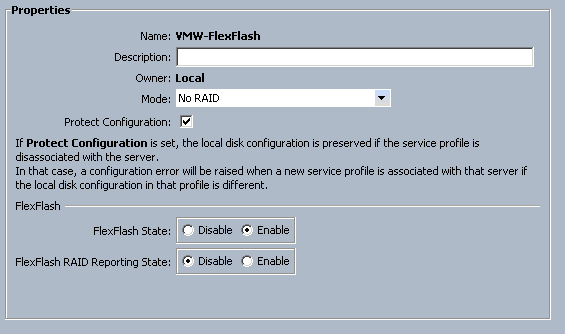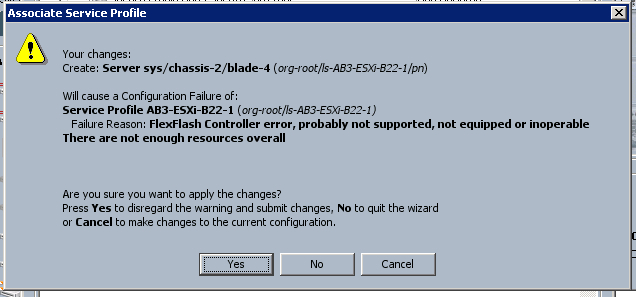Using FlexFlash SD on Cisco UCS B-series blades to boot ESXi
Newer UCS servers (both B-series blades and C-series rack mounts) have SD flash card slots that Cisco brands “FlexFlash”. Datasheets initially indicated that these flash slots were not usuable until a future release. With UCS Manager 2.2 and associated firmware the FlexFlash slots can now be used to boot ESXi, but getting the hypervisor installed can be a little tricky. A multi-step process may be needed, where a service profile that updates firmware and enables the FlexFlash state is applied first, and then the service profile is modified to include SD card in the boot order.
Update blade BIOS and Firmware to 2.2
Before starting, make sure the BIOS and CIMC versions on the blade are updated to the 2.2. versions. If they are not the service profile settings associated with the FlexFlash slots may produce errors that will prevent service profile association. If you are using the service profile to associate the 2.2 versions via a firmware policy, apply the service profile without having “SD card” in the boot order first, otherwise it may fail until the CIMC is updated.
Enable FlexFlash slots
Use of the FlexFlash slot is enabled via the local disk policy in the service profile (or template). Set “FlexFlash State” to “Enabled”.

If the firmware has not been updated, a “FlexFlash Controller error” will likely come up when trying to associate the profile.

Add SD card to boot order
Once the FlexFlash slot has been enabled (and assuming an SD card inserted - according to spec sheets up to a 16 GB card is supported), SD can be added to the boot order. I had to get the service profile associated that would set the proper firmware version, and enable the FlexFlash controller BEFORE I could add the SD card to the boot order - otherwise an error occured that prevented the service profile from being associated.

Once the SD card is part of the boot order, ESXi can be installed to the card by mounting the image to the KVM and installing just as with any other disk install.
In Summary
Booting ESXi off an SD card on the server is a nice alternative to using boot disk or boot-from-SAN. The dependancy on new firmware for CIMC and BIOS can just make it tricky to get things configured in one step (by just defining firmware update, FlexFlash state, and boot order up front in a service profile template) and may lead to errors when associating the service profile. Hopefully the steps outlined above will help minimize some issues I ran into.
Notes
This discussion on the Cisco Support Forums helped me get through some of these issues.
 ucs | in
ucs | in  Cisco Geekery
Cisco Geekery 